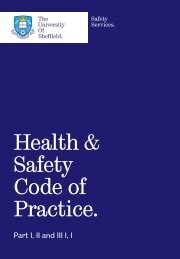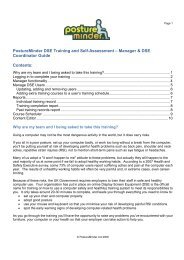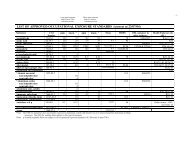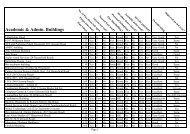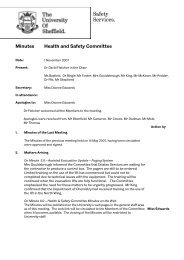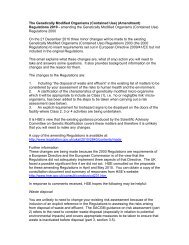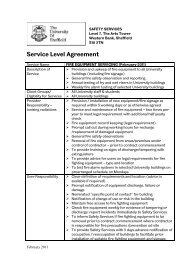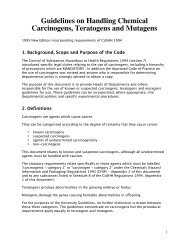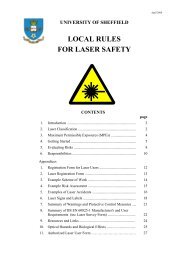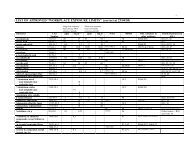DRIVING POSTURE.pdf - Safety.dept.shef.ac.uk
DRIVING POSTURE.pdf - Safety.dept.shef.ac.uk
DRIVING POSTURE.pdf - Safety.dept.shef.ac.uk
Create successful ePaper yourself
Turn your PDF publications into a flip-book with our unique Google optimized e-Paper software.
1<br />
l<br />
>- Physiotherapist and ergonomist, Jan Vickery, explains what companies can do<br />
to protect staff whose job involves a lot of driving from musculoskeletal injury.<br />
It is unusual to find a company<br />
that has given the highest priorit.y<br />
to the comfort of all its drivers<br />
when choosing its fleet. It's fair to<br />
say that in most cases, cost must rule.<br />
Function is often considered, but<br />
usually at a superficial level that is<br />
sometimes misinformed as it has not<br />
involved driver input or effective job<br />
evaluation. And the larger the group<br />
of drivers, the less likely it is..that one<br />
make/model of vehicle will fit all or be<br />
suitable for the mal"!Ydifferent job<br />
functions they use the vehicle for.<br />
Fleet managers are tnefefore well advised<br />
to consider erqonomks when selecting thein<br />
fleet, in particular in relation to "fit and >-<br />
"Fleet managers are<br />
well advised to consider<br />
ergonomics when selecting<br />
their fleet. "<br />
The RoSPAOccupational <strong>Safety</strong> & Health Journal April 2009 zs
~<br />
Health Matters<br />
function". Ideally a range of vehicle makes<br />
and models should be on offer for staff to<br />
choose from.<br />
Employees whose job involves a lot of<br />
driving every day are at risk of developing<br />
musculoskeletal problems such as b<strong>ac</strong>k or<br />
neck pain and lessoften hip, knee or foot<br />
pain. These workers should be screened to<br />
assesstheir potential risk of developing<br />
musculoskeletal problems. Screening can<br />
identify high risk drivers by asking them<br />
about driving exposure, discomfort, work<br />
<strong>ac</strong>tivities in the car and lifestyle. Screening<br />
can also help ensure that line managers take<br />
the correct <strong>ac</strong>tion to protect individual drivers.<br />
Those drivers who are identified as being<br />
at higher risk of developing musculoskeletal<br />
problems or who are already suffering from<br />
discomfort that they associate with driving,<br />
should be the subject of further, more in-<strong>dept</strong>h,<br />
assessment and advice.<br />
One of the most critical risk f<strong>ac</strong>tors for<br />
musculoskeletal trouble in occupational<br />
drivers is duration of driving. The threshold<br />
of exposure for occupational driving seems<br />
to be around four hours a day. Research<br />
conducted at Loughborough University<br />
showed that sickness absence in drivers due<br />
to b<strong>ac</strong>k pain was six times greater for drivers<br />
who drove more than four hours a day'.<br />
So for companies, there are obviously huge<br />
business benefits in spending time looking at<br />
vehicle design and dimensions and marrying<br />
these up with driver anthropometrics (body<br />
measurements) and job demands before<br />
choosing a fleet for their workforce, both in<br />
terms of productivity and complying with<br />
their legal duties. But to many firms, vehicle<br />
ergonomics is still an unknown area. Conducting<br />
an assessment is a good pl<strong>ac</strong>e to<br />
start.<br />
Assessment<br />
When a physiotherapist carries out an<br />
assessment of an individual driver, the first<br />
thing we look for are any physical difficulties<br />
the driver has. We use information provided<br />
by the company's occupational health or HR<br />
cont<strong>ac</strong>t, or from the driver's Gp' if available,<br />
and often the physiotherapist will assessthe<br />
person clinically too, to gain a full understanding<br />
of their physical problem. Armed<br />
with this information, the next step is to<br />
assessthe "fit and function" of the vehicle.<br />
This includes, but is not limited to, the<br />
following:<br />
• Details of driving: miles/annum, typical<br />
journey duration<br />
• Taskanalysis: what is the vehicle used<br />
for, for how long, other jobs<br />
• Vehicle details: make and model, locking,<br />
gearing, sat nav, hands free, boot design<br />
• Work organisation and routine: including<br />
breaking habits<br />
• Static driver posture: neck, b<strong>ac</strong>k, both<br />
lower limbs and both upper limbs<br />
• Posture during use of pedals, gears,<br />
handbrake, steering wheel, mirrors,<br />
displays, dials, signalling, windows, radio<br />
• Clearance around the body especially<br />
head and legs<br />
• Symmetry of the body, especially around<br />
the steering wheel and pedals<br />
• Dimensions of vehicle and equipment<br />
egoseat dimensions, distance to pedals,<br />
from steering wheel, boot height, boot<br />
sill height etc<br />
• Anthropometrics of driver<br />
• Adjustability of vehicle equipment,<br />
especially seat and steering wheel<br />
• Getting in and out of the vehicle<br />
• Use of vehicle for other tasks, especially<br />
loading<br />
By assessing all these f<strong>ac</strong>tors, it is possible<br />
to build an objective understanding of where<br />
a mismatch exists between the driver and the<br />
vehicle. Some are a patent mismatch in fit.<br />
For example, a 6ft 4 driver with neck trouble,<br />
who needed to bend his neck sideways to<br />
gain an unobstructed view through the<br />
front windscreen of his rather small vehicle,<br />
or a 5ft 2 delivery driver who couldn't re<strong>ac</strong>h<br />
the floor-level handbrake without nearly<br />
coming off her seat.<br />
But the vast majority of problems physiotherapists<br />
see revolve around vehicle seating<br />
"One of the most critical risk f<strong>ac</strong>tors for musculoskeletal<br />
trouble in occupational drivers is duration of driving. "
It is important to point out that vehicle manuf<strong>ac</strong>turers<br />
do spend a lot of money on research<br />
and development of vehicle seating. This<br />
seemsobvious but often surprises those that<br />
come up against difficulties in this regard.<br />
One has to remember that like most things<br />
"ergonomic" there must be compromise.<br />
Vehicle manuf<strong>ac</strong>turers include the following<br />
considerations, amongst many others, during<br />
seating design:<br />
• <strong>Safety</strong><br />
• The vehicle target population and their<br />
anthropometrics or body dimensions<br />
• Cost<br />
• Function<br />
• Limitations of the intended car dimensions<br />
• Other design aspects of the car<br />
Unlike workstation seating, provision of<br />
bespoke seating is not common in vehicles,<br />
but a seat that has a lot of adjustability is<br />
obviously more likely to fit more people (however,<br />
seating can still be difficult to get right<br />
for some drivers who have a particularly bad<br />
b<strong>ac</strong>k problem).<br />
Most drivers settle for an angle of about<br />
30 degrees b<strong>ac</strong>k from the vertical, with the<br />
hips sitting a little lower than the knees.<br />
This is in contrast to computer workstation<br />
seating, where a far less reclined posture is<br />
recommended. There is a good reason for<br />
this - work at a computer requires one to<br />
work forwards, whereas in driving, the steering<br />
wheel, gear stick and displays can be<br />
centred around the "reclined" posture. Of<br />
course, a driver does need to look ahead at<br />
the road so there is a limit to the amount of<br />
b<strong>ac</strong>krest recline and it needs to be balanced<br />
with the effect on neck posture.<br />
Some people are critical of the "reclined"<br />
position of vehicle seats. However, the re-<br />
"The vast majority of<br />
problems physiotherapists<br />
see revolve around vehicle<br />
seating. "<br />
clined posture is a perfectly good one provided<br />
that the s-shape of the spine is supported<br />
through good lumbar support. In<br />
f<strong>ac</strong>t, research has shown that the discs in the<br />
spine register less pressure when reclined up<br />
to 45 degrees from the vertical", Obviously<br />
for this to work, it's important to get all the<br />
adjustment right. There's no point in huddling<br />
forward over a steering wheel with the<br />
b<strong>ac</strong>k unsupported by a b<strong>ac</strong>krest that is too<br />
reclined.<br />
Function<br />
Poor function usually revolves around<br />
drivers using vehicles for jobs that they were<br />
not designed for. Evaluation of job demands<br />
should ideally be applied to all vehicles where<br />
driving is not the sole function for the vehicle.<br />
For example, in caseswhere the driver will<br />
be moving and handling objects in and out<br />
of the vehicle, a detailed evaluation of the<br />
job is particularly useful to inform the selection<br />
of ideal vehicle design.<br />
Solutions<br />
To address a mismatch between driver and<br />
vehicle, the first step is to try and work within<br />
the boundaries of what is available. Firstly,<br />
adjust what can be adjusted within the<br />
Health Matte rs<br />
vehicle (eg. seat, steering wheel, seatbelts)<br />
to get the driver into a comfortable and<br />
<strong>ac</strong>ceptable driving posture. Look at the driver's<br />
habits. How do they use the vehicle? For<br />
example, many sales personnel who spend a<br />
lot of time in their vehicle use a laptop whilst<br />
seated in the driver's seat - this is a habit<br />
that needs to be changed. Although not<br />
ideal, working in the passenger seat is far<br />
preferable than trying to work squeezed<br />
between the steering wheel and the seat.<br />
Also, drivers can develop poor postural habits,<br />
like leaning on an armrest which in turn<br />
causes the spine to side flex (bend).<br />
When conducting an assessment, sometimes<br />
physiotherapists come <strong>ac</strong>ross a vehicle<br />
"amendment" that is an attempt to solve a<br />
problem but has created a much larger one.<br />
For example, in one case,a lady had removed<br />
her seat's headrest because her pony tail<br />
banged against it causing her to poke her<br />
head forward, resulting in neck pain. She<br />
had lost sight of the f<strong>ac</strong>t that safety should<br />
never be compromised in the quest for comfort.<br />
Another example is cushions on drivers'<br />
seats. These are common - but they can<br />
sometimes render the seat unsafe.<br />
If after making all possible adjustments<br />
there is still a mismatch between the driver<br />
and vehicle, it may be necessaryto try a different<br />
vehicle. If one can be found within<br />
the existing fleet, all the better.<br />
It is recommended that drivers trial a<br />
vehicle before committing to it. Many fleet<br />
managers have the negotiating power to<br />
arrange a few days (or weeks ideally) trial of<br />
a vehicle. During a trial, it is useful to provide<br />
the driver with a detailed checklist, to help<br />
them evaluate the suitability of a vehicle. ~<br />
The RoSPAOccupational <strong>Safety</strong> & Health Journal April 2009 27
Further information<br />
• www.drivingergonomics.comis a website developed by a team led by Or Diane<br />
Gyi, a senior lecturer in ergonomics at Loughborough University. The team has<br />
conducted a lot of research on business driving and ergonomics.<br />
Guidance available on the site covers a range of issues associated with driving,<br />
including car selection, working from the car and seat adjustment, and there is a<br />
useful "Risk management filter" which has been developed as a result of the team's<br />
research findings.<br />
The site also includes a cost benefits checklist, the aim of which is to help OH<br />
professionals demonstrate to senior managers the business benefits of investing in<br />
the occupational health of drivers.<br />
The Highways Agency's Vehicle ergonomics best pr<strong>ac</strong>tice guide can also be downloaded<br />
from the website.<br />
• A guide to selecting cars for company drivers is available to down load for free from<br />
the Chartered Society of Physiotherapy's website: www.csp.org.<strong>uk</strong><br />
Takethe pain out of driving includes information on driving position and posture.<br />
• RoSPA'sroad safety department has published free guidance on the use of technology<br />
in vehicles. See:www.rospa.com/roadsafety/resources/employers.htm<br />
Health Matters<br />
"Poor function usually<br />
revolves around drivers using<br />
vehicles for jobs that they<br />
were not designed for. "<br />
This is especially useful when there may be a<br />
choice of vehicles available as checklists can<br />
be compared.<br />
Vehicle assessmentscan be made especially<br />
challenging by the inevitable "politics" that<br />
surround them. Typically, a fleet manager<br />
will be nervous of setting a precedent by<br />
providing a non-fleet vehicle or one that<br />
breaks the "status" ranks for an employee.<br />
However, following an objective assessment<br />
of a driver with b<strong>ac</strong>k pain, for example, the<br />
fleet manager has the justification for doing<br />
so and the flood gates can be held legitimately<br />
shut.<br />
Drivers can also raise objections to driving<br />
particular vehicles, objections which are<br />
simply not about vehicle ergonomics. I<br />
recently heard of a case of a driver who was<br />
convinced that only a new model high spec<br />
Mercedes would relieve his b<strong>ac</strong>k pain. However,<br />
through demonstration and education<br />
he was shown that one of the vehicles in the<br />
existing fleet was up to the job. He agreed<br />
to trial it and eventually kept it.<br />
References<br />
1 The prevalence of musculoskeletal<br />
troubles among car drivers. Porter, J.M.<br />
and Gyi, D.E, 2002. Occupational<br />
Medicine, 52, (1),4-12<br />
2 The way you sit will never be the same!<br />
Alterations of lumbos<strong>ac</strong>ral curvature and<br />
intervertebral disc morphology in normal<br />
subjects in variable sitting positions using<br />
whole-body positional MRI. 8ashir, W.<br />
et al. 2006. Radiological Society of North<br />
America Conference 2006<br />
(http://rsna2006.rsna.orglrsna2006)<br />
Jan Vickery is a member of ACPOHE<br />
(The Association of Chartered<br />
Physiotherapists in Occupational<br />
Health and Ergonomics). Members<br />
of the association specialise in<br />
the assessment. treatment and<br />
rehabilitation of people with workrelated<br />
musculoskeletal disorders.<br />
www.<strong>ac</strong>pohe.org.<strong>uk</strong><br />
The RoSPA Occupational <strong>Safety</strong> & Health Journal April 2009 29



